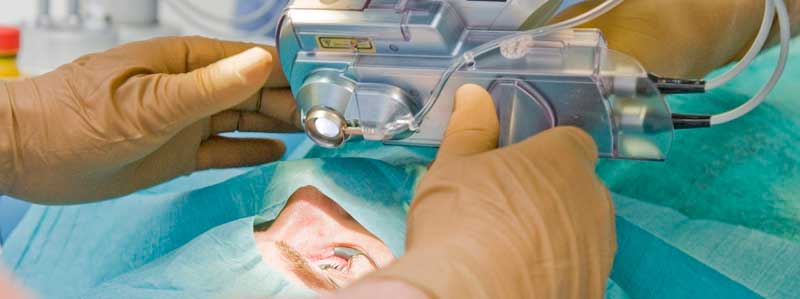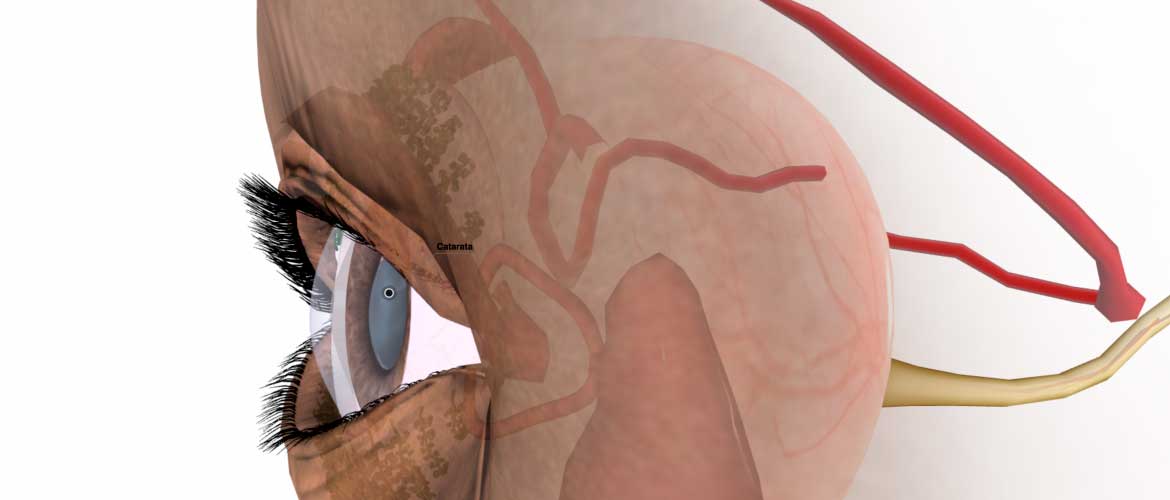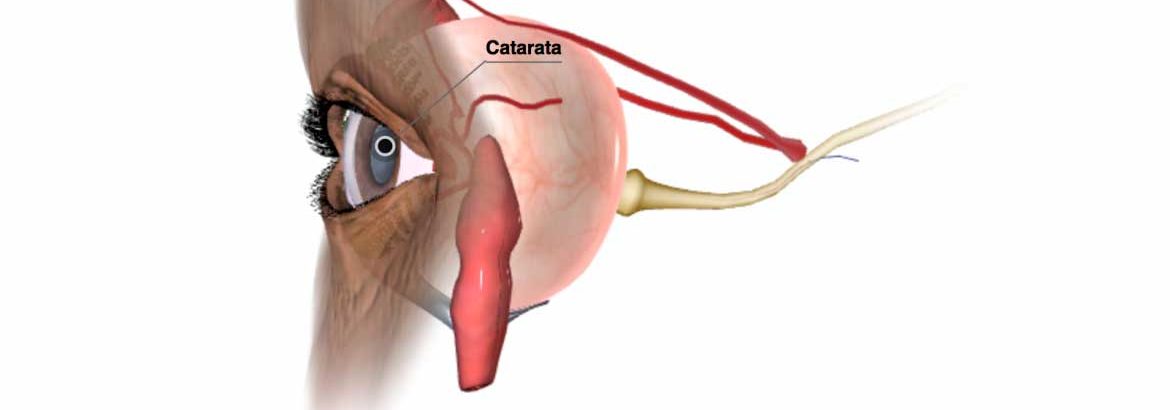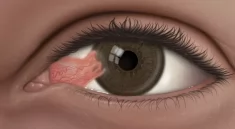



INFORMATION
Causes
The lens of the eye is normally clear. It acts like the lens on a camera, focusing light as it passes to the back of the eye.
Until a person is around age 45, the shape of the lens is able to change. This allows the lens to focus on an object, whether it is close or far away.
As a person ages, proteins in the lens begin to break down. As a result, the lens becomes cloudy. What the eye sees may appear blurry. This condition is known as a cataract.
Factors that may speed cataract formation are:
- Diabetes
- Eye inflammation
- Eye injury
- Family history of cataracts
- Long-term use of corticosteroids (taken by mouth) or certain other medicines
- Radiation exposure
- Smoking
- Surgery for another eye problem
- Too much exposure to ultraviolet light (sunlight)
In many cases, the cause of cataract is unknown.
Cataracts develop slowly and painlessly. Vision in the affected eye slowly gets worse.
- Mild clouding of the lens often occurs after age 60. But it may not cause any vision problems.
- By age 75, most people have cataracts that affect their vision.
Problems with seeing may include:
- Being sensitive to glare
- Cloudy, fuzzy, foggy, or filmy vision
- Difficulty seeing at night or in dim light
- Double vision
- Loss of color intensity
- Problems seeing shapes against a background or the difference between shades of colors
- Seeing halos around lights
- Frequent changes in eyeglass prescriptions
Cataracts lead to decreased vision, even in daylight. Most people with cataracts have similar changes in both eyes, though one eye may be worse than the other. Often there are only mild vision changes.
Surgery
Cataract surgery is an outpatient procedure. This means you likely do not have to stay overnight at a hospital. The surgery is performed by an ophthalmologist. This is a medical doctor who specializes in eye diseases and eye surgery.
Adults are usually awake for the procedure. Numbing medicine (local anesthesia) is given using eyedrops or a shot. This block pain. You will also get medicine to help you relax. Children usually receive general anesthesia. This is medicine that puts them into a deep sleep so that they are unable to feel pain.
The doctor uses a special microscope to view the eye. A small cut (incision) is made in the eye.
The lens is removed in one of the following ways, depending on the type of cataract:
- Phacoemulsification: With this procedure, the doctor uses a tool that produces sound waves to break up the cataract into small pieces. The pieces are then suctioned out. This procedure uses a very small incision.
- Extracapsular extraction: The doctor uses a small tool to remove the cataract in mostly one piece. This procedure uses a larger incision.
- Laser surgery: The doctor guides a machine that uses laser energy to make the incisions and soften the cataract. The rest of the surgery is much like phacoemulsification. Using the laser instead of a knife (scalpel) may speed recovery and be more accurate.
After the cataract is removed, a manmade lens, called an intraocular lens (IOL), is usually placed into the eye to restore the focusing power of the old lens (cataract). It helps improve your vision.
The doctor may close the incision with very small stitches. Usually, a self-sealing (suture less) method is used. If you have stitches, they may need to be removed later.
The surgery lasts less than half an hour. Most times, just one eye is done. If you have cataracts in both eyes, your doctor may suggest waiting at least 1 to 2 weeks between each surgery.
Outlook (Prognosis)
Vision may not improve to 20/20 after cataract surgery if other eye diseases, such as macular degeneration, are present. The eye doctor can often determine this in advance.
Risks
In rare cases, the entire lens cannot be removed. If this happens, a procedure to remove all of the lens fragments will be done at a later time. Afterward, vision can still be improved.
Very rare complications can include infection and bleeding. This can lead to permanent vision problems.
Before the Procedure
Before surgery, you will have a complete eye exam and eye tests by the ophthalmologist.
The doctor will use ultrasound or a laser scanning device to measure your eye. These tests help determine the best IOL for you. Usually, the doctor will try to choose an IOL that can allow you to see without glasses or contact lenses after surgery. Be sure you understand what your vision will be like after the IOL is implanted. Also, be sure to ask questions so that you will know what to expect of the surgery.
Your doctor may prescribe eyedrops before the surgery. Follow instructions exactly on how to use the drops.
After the Procedure
Before you go home, you may receive the following:
- A patch to wear over your eye until the follow-up exam
- Eyedrops to prevent infection, treat inflammation, and help with healing
You will need to have someone drive you home after surgery.
You will usually have a follow-up exam with your doctor the next day. If you had stitches, you will need to make an appointment to have them removed.
Tips for recovering after cataract surgery:
- Wear dark sunglasses outside after you remove the patch.
- Wash your hands well before and after using eyedrops and touching your eye. Try not to get soap and water in your eye when you are bathing or showering for the first few days.
- Light activities are best as you recover. Check with your doctor before doing any strenuous activity, resuming sexual activity, or driving.
Recovery takes about 2 weeks. If you need new glasses or contact lenses, you can usually have them fitted at that time. Keep your follow-up visit with your doctor.
Outlook (Prognosis)
Most people do well and recover quickly after cataract surgery.
If a person has other eye problems, such as glaucoma or macular degeneration or, the surgery may be more difficult, or the outcome may not be as good.
How long does it take to recuperate from cataract surgery?
After a couple of days, most of the discomfort should disappear. Often, complete healing occurs within eight weeks. Contact your doctor immediately if you experience any of the following: Vision loss
How should you sleep after cataract surgery?
Wear your protective eye covering while you sleep and avoid sleeping on the side that has been operated on.
Can you go blind from cataract surgery?
Yes, if left untreated, cataracts cause continual loss of vision, eventually leading to legal blindness or even total blindness. … For best results from cataract surgery, however, it’s generally recommended to have the surgery performed before the cataract causes low vision or legal blindness.
Will my eyeglass prescription change after cataract surgery?
Cataract surgery, which involves removing the eye’s cloudy lens and replacing it with a clear, artificial lens, is a common and very effective operation. … Many of the premium IOLs can indeed reduce the need for glasses post-surgery, but most people will continue to wear eyeglasses, at least some of the time
Can I watch TV after cataract surgery?
We ask that you do not read or watch tv at all during the first day of your eye surgery. After that first day of surgery, you may use your eyes as much as you want. You may engage in non-strenuous activities. It is best if you do not rub or touch your eye or any eye covering that may have been applied



